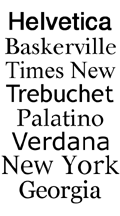some common typefaces:
 |  |
Typefaces
- The design of an alphabet
- usually subtle differences between fonts
- usually identified by
- designer (Baskerville)
- or refer to a place (Helvetica, New York, Georgia)
- or to describe its appearance (Futura, Modern-not shown)
Typestyles
-
- Roman.
The upright letterforms derived from the historic characters developed by the Romans. The majority of typeset copy is roman. It is the first typestyle we learn and most comfortable to read.
Italic.The second most common typestyle. A true italic typeface is not merely roman characters slanted to the right, but is specifically created to be a companion to the roman. Italic is used mainly for quiet emphasis. These words are written in italic. If a roman typeface is simply slanted to the right (or left), it is referred to as oblique.
Regular.The standard weight of a typeface, also referred to as normal. Regular is the basic form and weight from which all other variations are derived.
Bold.A thicker, heavier version of the regular typeface, commonly used for increased emphasis. Among the various designations for bold typestyles and heavier weights are semibold, heavy, black, extrabold, and ultra.
Light.A lighter or thinner version of the regular typeface. An extremely light version is often referred to as thin.
Condensed.A narrower version of the regular typeface. Condensed type is particularly desirable if it is important to fit more letters or a larger type size into a given space. Also referred to as compressed.
Extended.A wider version of the regular typeface.
Fonts
- was originally one size of one typestyle in a particular typeface
- today font still refers to a specific typestyle or typeface, but not a particular size
- may include punctuation and special characters (small caps, ligatures, old style figures, mathematical symbols, and diacritical marks).
Font Families
- all the typestyles of a given typeface
- typefaces such as Helvetica contain many variations ranging from thin condensed to bold extended, plus unique display faces such as outline and drop shadow.
Type Classifications
- all typefaces sharing visual characteristics are placed in a category
- The most familiar type classifications are Old Style, Transistional, Modern, Slab Serif, Sans Serif, Script, Black Letter, and Decorative.
|